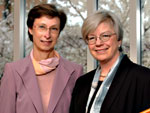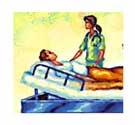![]() In the face of a national nursing shortage, leaders at the School of Nursing and Hopkins Hospital together are grappling with the challenge of making bedside nursing a “destination career.”
In the face of a national nursing shortage, leaders at the School of Nursing and Hopkins Hospital together are grappling with the challenge of making bedside nursing a “destination career.”
By Melissa Hendricks
 © ©Eric Westbrook |
During a mid-morning session of patient rounds at Johns Hopkins Hospital, nurse Kathleen Schenkel sits down in front of five doctors in a small, windowless office, opens a medical chart, and begins presenting the case of a 71-year-old woman who has suffered a stroke. Schenkel is a confident young woman and a fast talker. She rapidly describes the patient’s vital statistics, medications, and neurological exam results, reporting: “She looks brighter. She is tracking laterally. She’s not following commands, though.”
The physicians listen attentively, occasionally interrupting to ask a question. Schenkel then asks a few of her own: “Should she be on heparin? She’s on it now. I just want to know.” The doctors order a series of lab tests and medical consultations for the patient, and the medical team then adjourns.
It’s business as usual in the Hopkins Neuroscience Critical Care Unit (NCCU), where nurses and doctors gather every morning to discuss each patient under their care, a hospital custom known as morning rounds. But this way of doing rounds is a highly unusual business. In most hospitals and on most units at Johns Hopkins, doctors present patient cases during rounds while nurses, if they are even present, stand on the sidelines.
“Most people feel the doctor is on top,” says NCCU nurse manager Judith “Ski” Lower, who has served as an associate faculty member at the Johns Hopkins School of Nursing. “We don’t feel that way. We believe the nurse is shoulder to shoulder with the doctor.”
Lower initiated this way of doing rounds (along with several other progressive management practices) when she began as nurse manager. Many of the innovations have the effect of giving nurses greater autonomy than they have on other units, an attribute that Lower believes has helped her keep a high retention rate for her staff.
“I really like being part of the team,” says NCCU nurse Wendy Yan ’00. “The physicians make the [medical treatment] decisions, but the nurses participate. It’s important because the physicians see patients once or twice a day for five-minute interviews, but they don’t know the patients as well as the nurses do.”
Indeed, in the midst of a nationwide hospital nursing shortage, with some hospitals facing nurse vacancy rates as great as 20 percent (see p.19), Lower does not often lose an employee, and when she does, the position does not remain vacant for long. She has not used a contract or agency nurse for at least five years.
Success stories like this one capture the attention and imagination of nursing leaders like School of Nursing dean Martha Hill and Karen Haller, vice president for nursing and patient care services at Johns Hopkins Hospital. Both women are committed to tackling the nursing shortage together, by meeting frequently to brainstorm new ideas and by lobbying at the state and federal levels for legislation aimed at easing the shortage.
At issue: What steps can the school and hospital take to make bedside nursing a “destination” career? While many new nursing grads from Hopkins and elsewhere take up hospital nursing to gain experience, they often don’t stay for long. The reasons are myriad: Nurses today have a greater array of job opportunities to choose from, many of which pay better and offer more flexible schedules than the 12-hour shifts that hospital work requires. And, though hospital nursing has always been physically and mentally grueling, contemporary nurses must cope with patients who are sicker and who require more complicated care than ever before. Today’s nurses also face an avalanche of paperwork and other administrative tasks that take them away from the patient. “There is no rest, no lull at all,” says Hill. “This is full tilt the whole time for everybody.”
Against such a backdrop, burnout seems almost inevitable.
But it doesn’t have to be, says Hill. She views the nursing shortage as a new opportunity for Johns Hopkins School of Nursing. Traditionally, the school has garnered attention for turning its high-caliber students into leaders in community nursing, research, and policy. Now is the time, Hill says, to shine the spotlight on hospital-based nursing.
“If you want to do good, to help others, hospital nursing is a great way to do it,” she says. “Your ability and training can literally be a matter of life and death. As a bedside nurse, you are really like a battlefield commander. You need to synthesize a great deal of information, work with a team, and make things happen. It’s the ability of the nurse to be a critical thinker, to work well in a team and to think on her feet that makes a difference.”
Within the school, Hill and other faculty members and administrators are looking for ways to emphasize the possibilities for advancement and leadership that hospital nursing can afford. Their aim is to equip a new generation of hospital-based nursing leaders with the skills they will need to change the status quo.
The school recently received a $1.5 million grant from the Helene Fuld Health Trust to support undergraduate nursing students with strong leadership potential who are interested in hospital nursing careers. Each year, 40 students in the Leadership Fellows Program in Clinical Nursing will work in an interdisciplinary team of doctors, pharmacists, social workers, and nurses under the tutelage of a clinical nurse mentor. Each fellow will identify and study a clinical issue and propose solutions. This experience, school leaders hope, will show students the possibilities for improving patient care and encourage them to pursue hospital nursing.

“Nursing schools need to show students what hospital nursing is like, and do it realistically and in a supportive way,” says School of Nursing professor Maryann Fralic, former vice president for nursing at Hopkins Hospital. “The key is to show what real nurses do, and to dispel misguided notions about nursing, so that students understand that nurses are not subservient handmaidens,” she says.
“Every time I’ve asked nursing students why they are going into nursing, they all say they wanted that close relationship with patients and their families and the ability to make a difference,” says Fralic. If students can see that bedside nursing offers those opportunities, they will be excited about heading down that career path.
At Johns Hopkins Hospital, Haller is pursuing a similar goal. “We are seeking opportunities for our nurses to teach at the school and for [Martha’s] faculty to serve on our committees. It’s good for us because we are looking for our nurses to grow and have other opportunities. What keeps you in the job is if it’s interesting and you keep learning.”
In addition, Haller and other administrators have taken several concrete steps – from instituting new nurse training programs to introducing new technologies – aimed at filling in the gaps in the hospital’s nursing workforce. Only a constellation of strategies, Haller asserts, will provide the anodyne for the hospital nursing shortage.
“The Bedrock of Our Units”
 When the nursing shortage first struck Johns Hopkins Hospital about five years ago, Haller and other administrators knew they had three options. They could hire temporary nurses to fill vacancies. They could close patient beds. Or they could increase the patient-to-nurse ratio (At Hopkins, one nurse is responsible for one or two patients in the intensive care units, three patients in intermediate care units, and from four to six patients on the general medical and surgical floors.) “We chose not to increase the patient-to-nurse ratio,” says Haller. “We considered it not safe.” Instead they hired temporary nurses and closed some patient beds. At the same time, Haller took several steps to recruit and retain more nurses.
When the nursing shortage first struck Johns Hopkins Hospital about five years ago, Haller and other administrators knew they had three options. They could hire temporary nurses to fill vacancies. They could close patient beds. Or they could increase the patient-to-nurse ratio (At Hopkins, one nurse is responsible for one or two patients in the intensive care units, three patients in intermediate care units, and from four to six patients on the general medical and surgical floors.) “We chose not to increase the patient-to-nurse ratio,” says Haller. “We considered it not safe.” Instead they hired temporary nurses and closed some patient beds. At the same time, Haller took several steps to recruit and retain more nurses.
One program is aimed at helping newly minted graduates make the transition from nursing school to hospital bedside. This transition is normally a lengthy, time-consuming process for new nurses, as well as the mentors who guide them. “We have to invest one to two years to move [a nursing school grad] from novice to competent clinician,” says Haller. “For every new nurse, we need a mentor. That is wearing on the mentors.”
Through SPRING (Social and Professional Reality Integration for Nurse Graduates), a new nurse at Hopkins Hospital receives 144 hours of classes and clinical training during her first year on the job. The program, which is funded by a $1.8 million grant from the state of Maryland, currently has 75 nurse interns enrolled ó including eight recent graduates of the Johns Hopkins School of Nursing. By this summer, every new nurse coming into the hospital will go through the program.
SPRING also includes a research component. Program director Janice Hoffman interviews nurse interns as they progress through SPRING. And she conducts exit interviews with nurses who decide to leave the hospital. Her goal: to determine which factors contribute to nurse retention.
Hospital administrators are also working to retain their more seasoned nurses. In fall 2001, the hospital added a tuition plan to nurses’ benefits package. The plan covers half of the college tuition cost for children of Hopkins staff nurses. “It’s already helped us to retain our senior people ó mid-career people in their ’30s and early ’40s,” says Haller. “Experienced nurses are the bedrock of our units.” Since introducing the tuition benefit, the hospital’s nurse turnover rate has declined by 2 percent.
Money obviously factors into efforts to resolve the nursing shortage. “Fundamental to staffing a hospital is having a competitive compensation package,” says Haller, particularly when hospitals compete with other health care employers where nurses can work bankers’ hours. At Johns Hopkins Hospital, nurses’ salaries begin at $44,000 and can range upwards of $110,000 for the most senior, experienced nurses, with the median salary being $61,000. In addition, Hopkins Hospital nurses earn a $1,000 bonus for every six months of full-time employment. “Salaries have been raised significantly since the hospital started seeking solutions for the nursing shortage,” says Haller.
Of Budgets and Balance Sheets
 At the School of Nursing, faculty members are focusing on the nurses who are at the crux of the hospital nursing shortage: nurse managers. “Research indicates it is the head nurse or nurse manager who sets the tone for retention or recruitment of nurses,” says Hill. “They can transcend the difficulties. The leader who has motivated and challenged [her] staff and is constructive about solving problems ó those are units with low turnover.” (See p. 20.)
At the School of Nursing, faculty members are focusing on the nurses who are at the crux of the hospital nursing shortage: nurse managers. “Research indicates it is the head nurse or nurse manager who sets the tone for retention or recruitment of nurses,” says Hill. “They can transcend the difficulties. The leader who has motivated and challenged [her] staff and is constructive about solving problems ó those are units with low turnover.” (See p. 20.)
Unfortunately, many nurse managers lack management skills, says Kathleen Sabatier, MS, RN, director of the Institute for Johns Hopkins Nursing. So three years ago the institute (a collaboration between Hopkins School of Nursing and Hospital) established the Nurse Manager Academy to train nurse managers in management, communication, and negotiation. The seven-day intensive program, which attracts nurse managers from throughout the United States, includes seminars and workshops on tasks that nurse managers encounter daily: recruiting staff, disciplining and firing employees, resolving conflicts, negotiating with hospital administrators, communicating with authoritarian doctors, structuring a workplace so all employees participate in decision making.
One of the most popular sessions is an all-day financial management seminar. “The typical nurse manager runs a small business,” says Sabatier. “She has 40 to 100 full-time-equivalent employees and a multi-million dollar budget. It is pretty terrifying. She needs skills in how to read a balance sheet, how to prepare a budget.”
Other steps toward nurse retention are emerging from Hopkins’ one-year-old Center for Innovation in Quality Patient Care. While the goal of the center is to introduce innovations that improve patient safety and hospital efficiency, those same changes may have the added benefit of convincing more nurses to stay on the job (see p. 18).
“Medicine has become increasingly specialized and siloed,” says Johns Hopkins president William R. Brody, who is a member of the center’s executive steering committee. “We have a pharmacy and all these other groups responsible for a piece’ of the patient. Plus, we’ve layered on all sorts of administrative responsibilities that have taken the nurse away from the patient. So nurses become frustrated because they spend all their time tracking down medication from the pharmacy and doing all this [administrative] work.”
To reduce nurses’ workload and reduce medical errors, the hospital has introduced a handful of new technologies and is testing several others in pilot studies. Hopkins Hospital ICUs now have computerized medical charting systems to replace handwritten medical records. Some ICUs now have new beds with built-in scales and the ability to be converted into a chair. The benefit? Nurses don’t have to hoist patients from bed to scale to chair to bed.
In the medical ICU, medical teams are using a computerized intravenous pump system, which manages the flow of IV fluids and identifies potential errors. And on another unit, nurses wheel around “Nurse Diane,” a robotic patient-education system that consists of a flat-screen computer “face” and a pole-like “body” on wheels. Diane provides information for patients through interactive software, which leaves more time for the human nurses to perform their other tasks.
“These technologies will help us work smarter rather than harder with those nurses we have,” says Haller.
A Promising Downturn in Turnover
Both Haller and Hill say that despite the current nursing shortage, they are optimistic about the future of hospital nursing. Recent employment figures suggest that Hopkins Hospital’s efforts to recruit and retain more nurses appear to be working. The nursing turnover rate is 8 percent so far this fiscal year, down from 10 percent a year ago. The nursing vacancy rate has fallen from about 18 percent to about 10 percent. And the number of temporary, or contract, nurses working at Hopkins has dropped from 250 two years ago to 134 today. “So we’re definitely seeing an improvement, though we’re still worried for the long run,” says Haller.
Haller plans to continue efforts on several fronts toward reducing the nursing shortage at Hopkins, including applying for accreditation to the American Nurses Credentialing Center. The ANCC sets rigorous standards for patient care and nurse working conditions. Only a small fraction of the nation’s hospitals have garnered such status. Hopkins Hospital is currently completing the lengthy application process. Based on a study she requested two years ago, Haller says she believes the hospital meets the criteria.
At the School of Nursing, Hill and other faculty are heartened by an increase in applicants (applicants to the accelerated program doubled from last year to this year), and the possibility that other schools may be seeing similar increases. That’s good news, although not the total solution to the nursing shortage. Schools of nursing are also facing other problems, most notably a serious faculty shortage, which limits their ability to produce nurses.
The eternal optimist, Hill views the challenges of the nursing shortage as opportunities. A decade from now, she says, “the ideal will be to have the expertise of the nurse as someone who is able to assess what patients need, and plan for their care with the full knowledge of all other aspects of their care (such as the psychological and social components), and to do it in a compassionate and caring way that is evidence based. And this will be done in a context in which nurses are central members of the health care team.”
She is confident her vision will be realized.
Melissa
Hendricks writes from Annapolis, Maryland.
 You’re Welcome
You’re Welcome Nursing Named Most Trusted Profession for 22nd Consecutive Year
Nursing Named Most Trusted Profession for 22nd Consecutive Year Best of On The Pulse 2023
Best of On The Pulse 2023 From the Dean: Here & Now
From the Dean: Here & Now The Learning Collaborative: ‘I Think I Can, I Think I Can …’
The Learning Collaborative: ‘I Think I Can, I Think I Can …’







